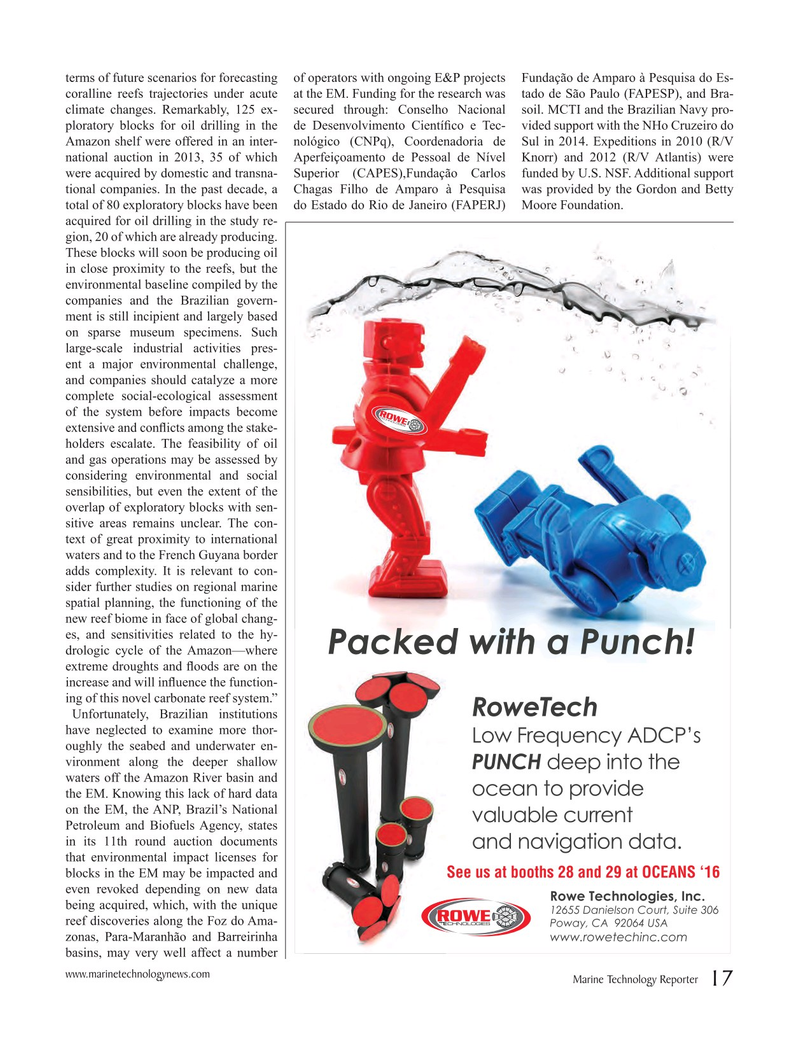
Page 17: of Marine Technology Magazine (September 2016)
Ocean Observation: Gliders, Buoys & Sub-Surface Networks
Read this page in Pdf, Flash or Html5 edition of September 2016 Marine Technology Magazine
terms of future scenarios for forecasting of operators with ongoing E&P projects Fundação de Amparo à Pesquisa do Es- coralline reefs trajectories under acute at the EM. Funding for the research was tado de São Paulo (FAPESP), and Bra- climate changes. Remarkably, 125 ex- secured through: Conselho Nacional soil. MCTI and the Brazilian Navy pro- ploratory blocks for oil drilling in the de Desenvolvimento Cientí? co e Tec- vided support with the NHo Cruzeiro do
Amazon shelf were offered in an inter- nológico (CNPq), Coordenadoria de Sul in 2014. Expeditions in 2010 (R/V national auction in 2013, 35 of which Aperfeiçoamento de Pessoal de Nível Knorr) and 2012 (R/V Atlantis) were were acquired by domestic and transna- Superior (CAPES),Fundação Carlos funded by U.S. NSF. Additional support tional companies. In the past decade, a Chagas Filho de Amparo à Pesquisa was provided by the Gordon and Betty total of 80 exploratory blocks have been do Estado do Rio de Janeiro (FAPERJ) Moore Foundation.
acquired for oil drilling in the study re- gion, 20 of which are already producing.
These blocks will soon be producing oil in close proximity to the reefs, but the environmental baseline compiled by the companies and the Brazilian govern- ment is still incipient and largely based on sparse museum specimens. Such large-scale industrial activities pres- ent a major environmental challenge, and companies should catalyze a more complete social-ecological assessment of the system before impacts become extensive and con? icts among the stake- holders escalate. The feasibility of oil and gas operations may be assessed by considering environmental and social sensibilities, but even the extent of the overlap of exploratory blocks with sen- sitive areas remains unclear. The con- text of great proximity to international waters and to the French Guyana border adds complexity. It is relevant to con- sider further studies on regional marine spatial planning, the functioning of the new reef biome in face of global chang- es, and sensitivities related to the hy- drologic cycle of the Amazon—where extreme droughts and ? oods are on the increase and will in? uence the function- ing of this novel carbonate reef system.”
Unfortunately, Brazilian institutions have neglected to examine more thor- oughly the seabed and underwater en- vironment along the deeper shallow waters off the Amazon River basin and the EM. Knowing this lack of hard data on the EM, the ANP, Brazil’s National
Petroleum and Biofuels Agency, states in its 11th round auction documents that environmental impact licenses for blocks in the EM may be impacted and
See us at booths 28 and 29 at OCEANS ‘16 even revoked depending on new data being acquired, which, with the unique reef discoveries along the Foz do Ama- zonas, Para-Maranhão and Barreirinha basins, may very well affect a number www.marinetechnologynews.com
Marine Technology Reporter 17
MTR #7 (1-17).indd 17 8/24/2016 5:10:42 PM

 16
16

 18
18
